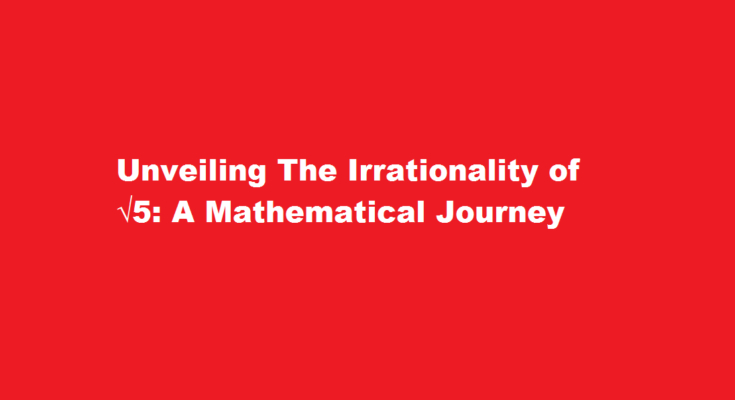Introduction
In the vast realm of mathematics, certain numbers possess unique characteristics that defy simple classification. One such intriguing entity is the square root of 5 (√5). Throughout history, mathematicians have endeavored to prove the irrationality of this enigmatic number. In this article, we embark on a captivating journey to explore various methods and proofs that establish the irrationality of √5, unraveling the inherent beauty and complexity of mathematical reasoning along the way.
Unearthing the Concept of Irrational Numbers
Before delving into the specifics of √5, let’s first comprehend the concept of irrational numbers. An irrational number is one that cannot be expressed as a fraction (ratio) of two integers. Unlike rational numbers, which terminate or repeat in decimal form, irrational numbers unfold infinitely without a discernible pattern. Examples of well-known irrational numbers include π (pi) and √2. Now, let us turn our attention to the intriguing case of √5 and investigate how it resists rationality.
Understanding the Square Root of 5 (√5)
The square root of 5 (√5) represents the positive solution to the equation x^2 = 5. However, √5 cannot be expressed as a simple fraction, making it an irrational number. To prove this, mathematicians have employed various methods throughout history, utilizing elegant proofs and mathematical reasoning. Let us explore some of these techniques, each contributing to the fascinating puzzle of irrationality.
Proof by Contradiction: A Classical Approach
One of the classical methods to prove the irrationality of √5 is by contradiction. Suppose √5 is rational, implying it can be expressed as a fraction in the form p/q, where p and q are integers with no common factors other than 1. Squaring both sides, we obtain 5 = (p^2)/(q^2). Rearranging, we find p^2 = 5q^2, which implies that p^2 is divisible by 5. Consequently, p must also be divisible by 5. Let p = 5k, where k is an integer. Substituting this back into the equation, we have (5k)^2 = 5q^2, yielding 25k^2 = 5q^2. Simplifying further, we find 5k^2 = q^2. This implies that q is also divisible by 5. However, if both p and q are divisible by 5, it contradicts the initial assumption that p and q have no common factors other than 1, leading us to conclude that √5 is irrational.
Continued Fractions An Alternate Perspective
Another captivating approach to demonstrating the irrationality of √5 involves the use of continued fractions. By representing √5 as an infinite series of fractions, we can observe a distinct pattern that reveals its irrational nature. For √5, the continued fraction can be expressed as [2; 4, 4, 4, …]. This implies that √5 is not only irrational but also a quadratic irrational, as it exhibits a repeating pattern in its continued fraction representation. Through mathematical analysis and examination of its continued fraction expansion, we can ascertain that √5 is indeed an irrational number, further cementing its elusive nature.
Frequently Asked Questions
How do you prove root 5 is irrational questions?
Assuming √5 as a rational number, i.e., can be written in the form a/b where a and b are integers with no common factors other than 1 and b is not equal to zero. It means that 5 divides a2. This has arisen due to the incorrect assumption as √5 is a rational number. Therefore, √5 is irrational.
What is the irrationality of the square root of 5?
It is an irrational algebraic number. The first sixty significant digits of its decimal expansion are: 2.2360679774997896964091736687312762354406183596115
Conclusion
The journey to prove the irrationality of the square root of 5 (√5) has taken us through various mathematical paths. From classical proof by contradiction to the exploration of continued fractions, each method reinforces the fact that √5 cannot be expressed as a simple fraction. The enigmatic and captivating nature of irrational numbers, such as √5, leaves us in awe of the intricacies of mathematical reasoning. As we unravel the mysteries of these numbers, we gain a deeper appreciation for the elegance and beauty that lie at the core of mathematics, fueling our curiosity and driving our pursuit of further knowledge in this enthralling field.
Read Also : Unraveling The Secrets of Onto Functions A Guide to Proving Their Validity



